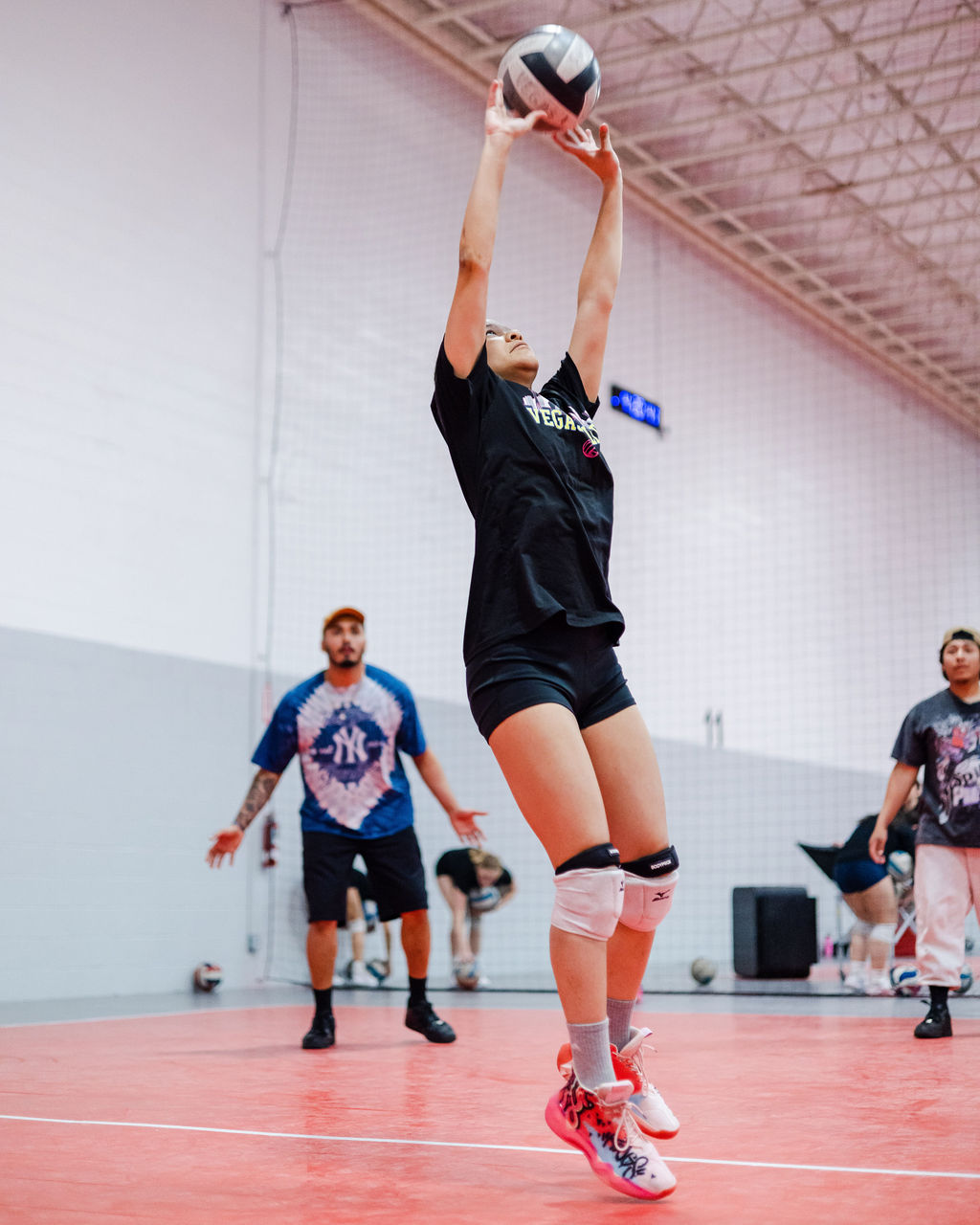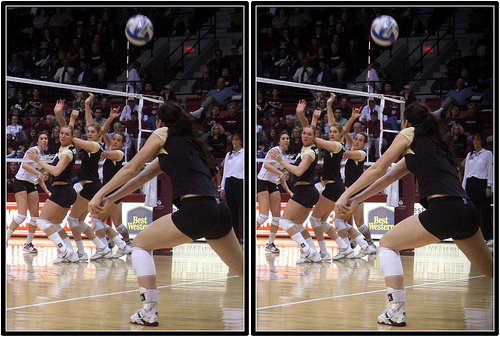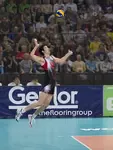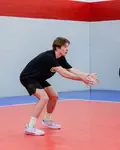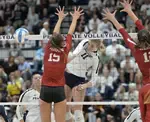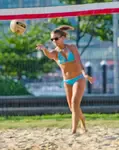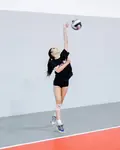- Improve Your Volleyball with Coach April
- Basic Volleyball Skills for Beginners
Basic Volleyball Skills: Six Essential Skills Varsity Players Know
Trying out for varsity? There are 6 basic volleyball skills, you need to learn beforehand: setting, passing, serving, hitting, blocking and digging.
Are you a beginner volleyball player trying out for the junior varsity or varsity team?
Learn these six essential volleyball skills that every beginner should know before stepping on the court: setting, passing, serving, hitting, blocking, and digging.
Let's review these six essential volleyball skills
basic rules , rotations, terminology and court information you need to know if you intend to try out for the varsity team.
Essential Basic Volleyball Skills: What is Serving in Volleyball?
What is the serve?
The serve is your first opportunity to score a point against the opposing team. Its the only skill out of 6 that you perform by yourself and don't depend on anyone else to help you score a point.
To serve the ball is sent over the net to start the rally by the player in Zone 1, the right back area of the court either with an over the head contact after tossing the ball in the air or with an underhand serve technique.
Passing Basics in Volleyball
How to Pass the Ball
A Volleyball Beginner's Guide
The pass or the bump is used to describe the most commonly used technique to transfer the ball from one player to another or over the net.
The pass is traditionally used to make the first contact of the ball after its been served into your court by an opposing team.
How to Pass the Ball
A Volleyball Beginner's Guide:
How do you pass the ball?
The pass is a service reception technique usually made when your team is on offense done by
step 1.
- clasping your two wrists together
step 2.
- using one of three popular hand grips to hold your hands together while
step 3.
- keeping elbows straight by pointing the thumbs to the ground
step 4.
- contacting the ball on your forearms below your elbows and above your wrists, not on your closed fists
step 5.
- making contact under the bottom third of the ball to lift it in the air directed to another player or over the net
Basic Volleyball Skills -
What is Setting?
A Guide for Beginners
 Basic Volleyball Skills -
What is Setting?
A Guide for Beginners: A set is a way you contact the ball over your head to get the ball to travel from you to another person or over the net . (Ralph Aversen)
Basic Volleyball Skills -
What is Setting?
A Guide for Beginners: A set is a way you contact the ball over your head to get the ball to travel from you to another person or over the net . (Ralph Aversen)What is a set?
A set is a way you contact the ball over your head to get the ball to travel from you to another person or over the net .
- Both arms are outstretched above your head with shoulders close to your ears.
- Both hands with palms wide open face the target you are setting
- Once the ball contacts the fingertips of your hands you push it back up into the air towards your target, setting the ball up for the next person to contact it.
The set is usually the second contact in a rally and the person who sets the ball the most is called the setter.
A Volleyball Beginner's Guide -
What is an Attack Hit?
Basic Volleyball Skills on Spiking
An attack hit can be a spike which describes the technique commonly used for the third contact in a rally that sends the ball over the net with power.
A spike starts with an approach of three but quite often four steps.
The first two slow and the last two bigger and faster steps that propel you in the air gathering momentum as you go, to lift you above the top of the net so you contact the ball at its highest height to attack or hit it down into the opposing court.
As you become a better spiker and your hitting technique improves, you will learn to spike faster and quicker sets that are lower to the net.
Volleyball Basics - What is Blocking?
A Guide for Beginners
Basic Volleyball Skills on Blocking
A block is the first opportunity for a team on defense to keep the team on offense from hitting into their court.
The three defensive players in your front row are blockers standing with their hands at their shoulders watching the opposing team pass the ball then set the ball, then hit the ball..
When they hit its the job of the blockers to block the ball back into their court so that it doesn't come over the net.
If the block stops the ball at the net and the ball goes back to the opposing teams floor, that's a point for the block, your team, your team gets to rotate and serve.
If the block does not stop the ball, then your three players in the back row have to dig the ball up to keep the rally going.
A Beginner's Guide to Volleyball -
What is a Dig?
Now its the responsibility of the three back row players on defense to keep the ball off the floor.
They do that by "digging the ball".
The dig" is an underhand technique that describes the first contact of a ball in a rally that's been sent over the net with power.
To "dig a ball" you are in a defensive position, most frequently in the back row, with wrists and thumbs clasped tightly together creating a platform with your forearms which contacts the underside of the ball.
The "platform" arms are angled toward the area where the ball needs to travel to.
|
|
|
Volleyball Basics:
Where Do You Go From Here?
What you just read was just a warmup!
Just like in volleyball practice, you do a little stretching to warm up your muscles before getting into the real meaty part of practice.
Here you go through a light review of everything before you really begin to dig deep and take each rule, each position, each skill and really explore it.
Learn to do tons of reps and go over each drill repeatedly until you get it right.
Where do you need to go now? Here are two options:
- Learn more about How to Play Volleyball by exploring the Related Links below.
- Follow the suggested reading on our Sitemap page Learning How To Play (Sitemap)
From Lady Vol to Legend: Coach April Produces Powerful Passionate Players...is that you?
What Are You Looking For?
Click to Download Your Pre Serving Ritual Mastery Checklist pdf:
🎯Volleyball Pre Serving Ritual Guide -
Players! Learn How To Transform Your Serve from Weak to Weapon
Click to Download Your Parent's Volleyball Serving Checklist pdf
🎯Parent's Volleyball Serving Checklist Guide
Parents! Help Your Player Develop Championship Serves (Even If You've Never Played)

Hi there!
Thanks for stopping by. Hope you learned something today that will help you reach your volleyball goals.
Be sure to subscribe to my email newsletter so you can learn more each week!
Stay strong! Stay motivated!
-Coach April

SUSCRIBE to my email newsletter below!
 Click to learn more about the weekly volleyball classes and clinics or email info@imrpoveyourvolley.com for information
Click to learn more about the weekly volleyball classes and clinics or email info@imrpoveyourvolley.com for informationCongratulations to my seven Boys-18s Vegas Volley club players who played in two state championship finals yesterday, the 3A and 5A State champinship finals at Sunrise Mountain High School.
TOURNAMENT CHAMPIONS!
A-1 Vegas Volley VBC
In It To Win It Tournament
May 2 - 4, 2025 Tournament
Gold Medalists
18s Premier Division
Vegas Volleyball's Unsung Heroes: Celebrating Moms with Peace Love Volleyball Shirts
Ready to energize your volleyball mom journey?
Subscribe to my 'Producing Powerful Passionate Peaceful Players' email list above on ImproveYourVolley.com.
You'll receive energy-boosting tips, exclusive insights from me, Coach April Chapple on maintaining momentum in volleyball.
Let's power up the Vegas volleyball scene together!
Recent Articles
-
Your Serve in Volleyball: 10 Tips To Get You From Bench to Starter
Jan 02, 26 03:41 PM
I hold Tennessee's #2 career aces record (244 aces). Last month I coached 7 players to state finals. These 10 serving tips separate legends from bench players. -
Overhand Jump Serve Volleyball Tips To Score Many More Points and Aces
Jan 02, 26 03:14 PM
My "Coach April Overhand Jump Serve Volleyball Tips" designed to help you increase your serving accuracy, power and the ability to serve more aces in volleyball. -
How To Serve In Volleyball Two Tips On How To Develop A Tough Serve
Jan 02, 26 03:05 PM
Learn how to serve in volleyball with step-by-step instructions. Could adding 3 aces per game make you a starter? My complete guide is for all skill levels


